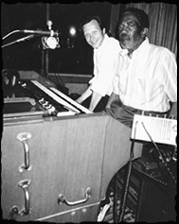by Jeff Miers
Buffalo News
When trying to lure local musician David Kane to compose music for his independent film “In,” writer, director and Buffalo native Peter McGennis told him: “New Orleans is a character in this film, and that character speaks through music.”
That, apparently, was music to Kane’s ears.
Kane composed the music and 15 local musicians also lent their talents to the 90-minute movie. The cast of the mob story also includes defense attorney Paul Cambria in a small role.
Watching it, one is immediately taken by the prominent, indelible role that music plays in constructing the noir-ish, dense psychological world McGennis’ characters inhabit.
“When Peter and I began this project, we decided to use (famed Blue Note Hammond organist) Jimmy Smith as a jumping-off point,” says Kane. “I wrote the music with Jimmy’s classic material sort of spinning on a tape loop in my head. I pictured him playing this stuff, and it really lent authenticity to the project. It gave me a mental image of what I was shooting for.

“Little did I know I’d actually end up sitting at the organ with the man and teaching him my music.”
Unbeknownst to Kane, McGennis had tracked down Smith in Italy and convinced him to take part in the film soundtrack. He phoned Kane, dropped the news and told him to pack his bags; they’d be recording with Smith in Hollywood in two weeks.
“Unbelievable,” is about all Kane was capable of muttering last week, as he shook his head and grinned while seated in the control room of Propellerhead Studios in Buffalo. The previous evening, Kane was a guest of honor as “In” played to an invite-only crowd of about 200 in the Market Arcade Film and Arts Centre. When Kane’s name rolled in the opening credits, the theater erupted in applause.
Kane is visibly thrilled with the experience. Not just with fulfilling a lifelong dream — to work with the legendary Smith, whose recordings suggested that the blues could swing and who is widely held to be the cream of his genre’s crop — but with how well his music works in the film.
“The music was supposed to help tell the story, and I think it managed to do that,” Kane smiles.
McGennis has noted Kane’s “clever mind for grooves and funky hooks,” and with the same understatedness that is a great boon to his film, he seems to have hit the nail squarely on its head. Kane’s ear for distinctly human rhythms — walking, dancing, breathing, trembling — has long been in evidence throughout his work with Them Jazzbeards and the David Kane Quartet.
And though the film, set in New Orleans, might have worked well with a strictly traditional “N’awlins” score, Kane has created an evocative music that suggests strong familiarity with tradition while simultaneously boasting a fierce individualism.
“In” was, however, clearly a product of intensive collaboration. McGennis contributed all of the lyrics to the gorgeous Kane tune “Leave Myself to Chance,” given voice by Maria Muldaur.
Kane and McGennis also called upon a handful of the many wonderful musicians living and working in Buffalo to take part in the project. Drummers-percussionists Rob Lynch, Bill Moore and Greg Gizzi, guitarists Jim Whitford and Doug Yeomans, and bassist Kent Weber all contributed.
That excitement comes through during several of the key grooves employed throughout “In” and lends to the unfolding action, both external and internal. It’s remarkably exciting, compelling and often funky music. And, perhaps most importantly, it helps “In” succeed as a film.
The immediate plan is to take “In” to the festivals and perhaps look for major distribution. There are no confirmed dates for a Buffalo opening yet.
